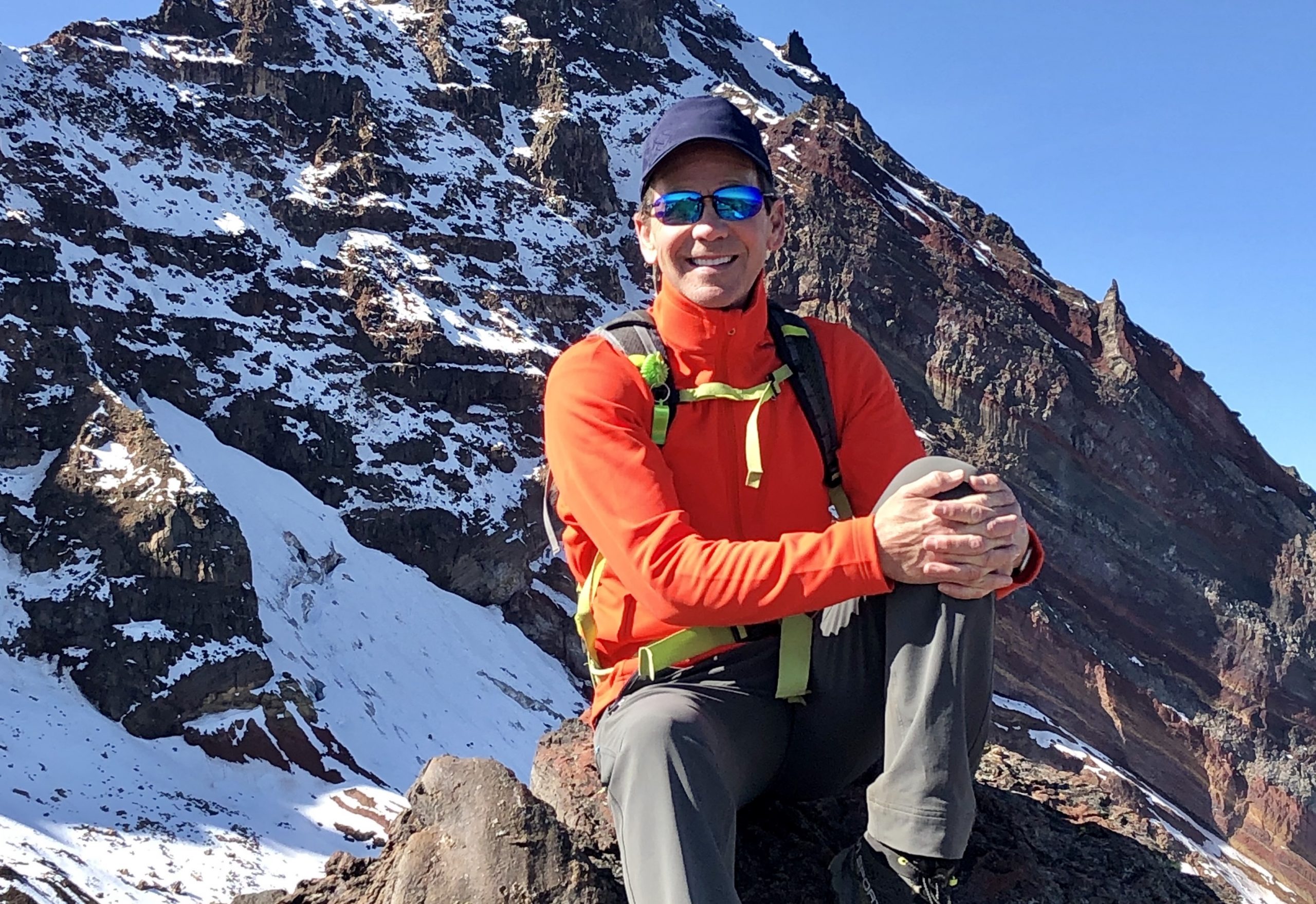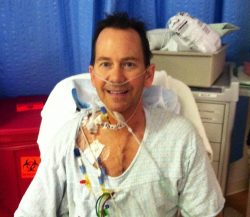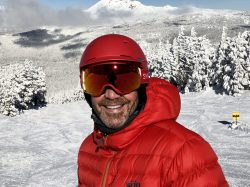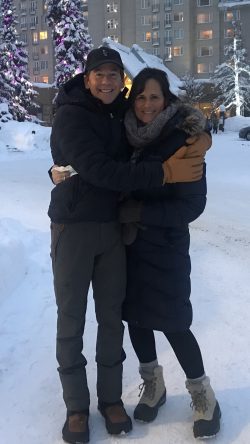
Michael’s Story: The Heart to Carry On
One early morning in 1997, 35-year-old Monterey Peninsula resident Michael V. had difficulty sleeping due to an unusual feeling. “My heart was pounding away as if it was going to come out of my chest,” he said. He called for his wife, who rushed over to him. Michael looked at her, knowing something wasn’t right, and said, “I think I’m going to die.” Then his heart stopped.
 After Michael was revived in his home by paramedics his wife had called to the scene, an ambulance rushed him to the hospital, where a medical team began treating him. The following day, he was in the ICU when his cardiologist told him that he had suffered a major heart attack and a third of his heart was now dead. Michael was told he would need to be transported to another hospital where they had more testing, equipment and specialists to investigate his case more closely. He said, “I remember thinking, ‘What in the world has happened to me?’” His treatment at the second hospital required him to be admitted ten days, after which time he was discharged with a defibrillator in his chest. Ultimately, Michael was diagnosed with cardiac sarcoidosis, a rare condition that occurs when groups of immune cells form granulomas (areas of inflammation) in a person’s heart.
After Michael was revived in his home by paramedics his wife had called to the scene, an ambulance rushed him to the hospital, where a medical team began treating him. The following day, he was in the ICU when his cardiologist told him that he had suffered a major heart attack and a third of his heart was now dead. Michael was told he would need to be transported to another hospital where they had more testing, equipment and specialists to investigate his case more closely. He said, “I remember thinking, ‘What in the world has happened to me?’” His treatment at the second hospital required him to be admitted ten days, after which time he was discharged with a defibrillator in his chest. Ultimately, Michael was diagnosed with cardiac sarcoidosis, a rare condition that occurs when groups of immune cells form granulomas (areas of inflammation) in a person’s heart.
For many years, Michael was able to manage his condition through light exercise and routine checkups. Over time, however, his heart showed signs of gradual deterioration; by about 2012, his heart was working less than 20 percent. At that point, Stanford Hospital, where he was now receiving care, felt it was necessary to put him on the heart transplant waiting list. It took 19 months, but he finally received his life-changing news: at 2AM on August 11, 2013, Stanford Hospital called him saying they had a heart. Michael was so excited about his new heart, he said, “I was smiling ear to ear.”
After 12 hours of surgery, Michael emerged from the operating room with a new heart. While the surgery was swift, the anticipated recovery was long; but Michael was determined to push through.
From running 4–5 miles a day to being a black belt in karate, Michael had always seen an active lifestyle as part of his identity. In particular, he had spent years of his life as an avid skier. After his surgery, however, he had to be more cautious about what he could and could not do and had limitations that he had to navigate around to protect his health.
Despite his limitations, he was determined to find ways to ease back into doing the things he loved. Although he couldn’t engage in all his favorite activities straight away, he knew that if he did lower-impact cardio, such as walking and lifting weights, it would be easier on his heart. This part of the recovery was difficult for Michael, as his favorite activities, such as running and skiing, were how he relieved stress. Additionally, he had three children who had inherited his athleticism and loved being active. “Sitting on the sidelines was tough,” he said. “My kids were in sports, and it was hard to be on the bench! I wanted to play soccer with them.”
 After about seven months of determination and slowly increasing his physical activity, Michael was finally ready to hit the slopes. His doctors were shocked at how quickly he was progressing after his transplant. It was an incredible achievement that showcased all of Michael’s hard work and dedication. He was slowly, but surely, returning to his true self.
After about seven months of determination and slowly increasing his physical activity, Michael was finally ready to hit the slopes. His doctors were shocked at how quickly he was progressing after his transplant. It was an incredible achievement that showcased all of Michael’s hard work and dedication. He was slowly, but surely, returning to his true self.
Then, ten months after his surgery, just as Michael was getting back into the swing of things, he was dealt a significant blow: he had a stroke and lost sight in his left eye. “Suddenly, when everything you see is blurry, life becomes blurry,” he said. For the first time in his life, Michael felt depressed. Eventually he decided to confide in a friend who was also a heart transplant recipient, which had a significant impact. Michael recalled, “I went home from that conversation and thought about what my friend said, and how she put things in perspective: A heart is life; eyesight is only quality of life.” Ultimately, he was thankful for the opportunity at life he had been given and decided to make the best of his situation, despite its challenges. Michael realized how powerful his mind could be during this transitional time in his life. He focused his energy on his favorite activity, skiing. “I would concentrate on the things I could do, not on what I could not do,” he said.
 During the next few years of recovery, Michael relied heavily on the support of his family, which kept him motivated, optimistic and hopeful. “My favorite time was when we were all gathered around the dinner table. We would all sit down and talk about each other’s day,” he said. Michael wanted his three kids to go to college and have as many opportunities as he could help to provide, so he kept persevering to give his family the best life possible.
During the next few years of recovery, Michael relied heavily on the support of his family, which kept him motivated, optimistic and hopeful. “My favorite time was when we were all gathered around the dinner table. We would all sit down and talk about each other’s day,” he said. Michael wanted his three kids to go to college and have as many opportunities as he could help to provide, so he kept persevering to give his family the best life possible.
Now, nearly 10 years after his surgery, Michael is back to his active lifestyle, taking over one ski slope at a time. Michael also hit a significant milestone in achieving one of his lifelong dreams: “Right before I went into surgery, the doctor had asked me why I wanted the procedure. I thought about it, and I wanted to walk my twin daughters down the aisle one day,” he replied. In 2022, Michael had the honor of walking his first daughter down the aisle. “I was on cloud nine at the wedding,” he said.
Michael is passionate about sharing the importance of organ donation. There are currently more than 105,000 individuals on the national organ transplant list. “I try to make people think about becoming an organ donor. You can save so many lives. It’s an amazing thing,” he said.
To support the cause, he currently serves as part of Stanford Health Care’s Patient and Family Partner Program (PFPP), chairing the Heart Transplant Patient and Family Advisory Council (PFAC). “I wanted to give back,” he said. “Anytime you give back, you get it back in double.” PFAC has been a particularly fulfilling outlet for him, as it helps ensure the voices of heart transplant patients and their families are heard while providing consistent support and guidance to help them navigate their transplant journey.
A key component of supporting opportunities for transplants is ensuring there are enough people on the donor registry, but also ensuring there is enough blood to perform these surgeries, as many organ transplants — particularly heart transplants like Michael’s — are dependent on significant generosity from blood donors. You can help support patients such as Michael by donating blood regularly and registering to become an organ donor. Learn more at stanfordbloodcenter.org/sbc-dnw.
